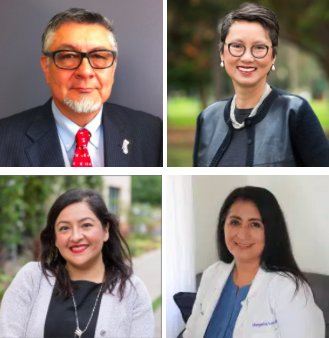COVID PANDEMIC LAYS BARE CRITICAL SHORTAGE OF LATINX HEALTH CARE PROFESSIONALS

Clockwise from top left: Dr. David E. Hayes-Bautista, Distinguished Professor of Medicine, UCLA David Geffen School of Medicine; Van Ton-Quinlivan, CEO, Futuro Health; Margarita Loeza, MD, Chief Medical Officer, Venice Family Clinic, and Co-founder, MiMentor; Hortencia Armendariz, Healthcare Justice Division Director, SEIU-UHW
By SUNITA SOHRABJI/EMS Contributing Editor
California needs at least 54,000 more physicians who speak Spanish to serve the health care needs of the state in which Latinx people are 40 percent of the population.
At the same time, there’s a looming shortage of bilingual health care workers – some 500,000 by 2024. The demand for applicants – made more urgent by the COVID-19 pandemic — should come as good news for Latinx communities who’ve been hardest hit by COVID-19 and related job losses.
This was the message of health care professionals speaking at a Nov. 10 news briefing for Spanish language media on behalf Futuro Health, a nonprofit agency established jointly by Kaiser Permanente and SEIU-United Healthcare Workers West to help meet the shortage. The briefing highlighted the launch of Futuro’s “Tu Nuevo Futuro” campaign to train 1,000 Spanish dominant speakers via a tuition free, healthcare-specific online English readiness course.
California is home to 14.5 million Latinx residents, but currently has just 7,000 physicians who speak Spanish. While non Hispanic-White people have 315 doctors for every 100,000 people, Latinx people have just 105, said Dr. David Hayes-Bautista, director of the Center for the Study of Latino Health and Culture UCLA’s School of Medicine. He added that there are just small handfuls of Latinx students enrolled or graduating from medical school. In dentistry, the disparity is even more stark: there are 88 dentists per 100,000 non-Hispanic Whites, but just 17 for the Latinx community.
California has exacerbated the shortage by limiting the number of residencies for international medical graduates, said Hayes-Bautista. Foreign medical graduates hoping to work in the U.S. must first undergo a three step re-licensing process which involves completing a residency in the U.S.
Futuro’s “Tu Nuevo Futuro” program seeks to build a pipeline of Spanish speakers aiming to pursue a career in the health care industry. The course, which can be completed online in three to five months with three to six hours of study per week, equips students with medical terminology and other skills.
Participants in the program can then go on to colleges which offer certification in medical assisting, nursing assistants, licensed vocational nurses, radiology technicians, and related careers in the rapidly growing health care industry. Participants must be at least 18, speak Spanish as their dominant language, and have online access.
“Our nation needs a health care workforce reflective of the communities being served,” said Futuro Health CEO Van Ton-Quinlivan. “Being bilingual is an asset, and we hope more people will seek out careers in health care or better navigate care for their loved ones thanks to this English readiness course,” she said.
Most allied health care jobs require at least a high school diploma but do not require a baccalaureate degree, Tom-Quinlivan added. “There’s a whole worth out there in health care besides doctors and nurses.”
Hortensia Armendariz, executive committee member of the Service Employees International Union, which represents 100,000 allied health care workers, including 50,000 people in California, said she is proud that her members have been on the front lines of support during the COVID-19 pandemic. “Right now, you drive by every hospital and you see ‘Health care Heroes.’ Well, those are our members,” she said.
“The pandemic has really demonstrated that we need competent bilingual services at every hospital, and at every clinic,” said Armendariz, explaining that the quality of care improves if the provider and patient can understand each other.
Dr. Margarita Loeza, chief medical officer at the Venice Family Clinic in Southern California, said as a high school student with straight As, she was discouraged from pursuing medicine “because my skin is brown and I’m a woman.”
The physician and her colleagues developed Mi Mentor — mimentor.org — which mentors under-represented students, including DACA recipients who are interested in medical careers. The program started out mentoring Latino medical students, but now supports Latinos studying to be medical assistants, pharmacists and related pursuits.
“The pharmacist has to speak Spanish. The pharmacy tech has to speak Spanish. We can’t send our patient at the pharmacy and the pharmacist doesn’t speak Spanish. Our treatment is not going to work,” said Loeza.
“One of the most frustrating things during this pandemic is seeing that Latinos are dying more than any other group and knowing that some of the answers are that we need more Latinos in the health professions,” she said.
Rosalie Garcia Bernal, a medical assistant at Kaiser Permanente, said she too was discouraged by a high school counselor from pursuing a medical career. She persisted nonetheless. Her first job was in East San Jose where she spoke Spanish with patients all day long. “I didn’t realize the need in the community.”
Bernal was hired by Kaiser because of her Spanish skills and has been interpreting there for over 30 years. She said that besides good and steady compensation, she has created a family relationship with many of the patients, who she first saw as babies, and are now bringing their babies to the clinic.
Viviana Row, a recent immigrant from Colombia who recently completed the English readiness course, called it an excellent stepping stone in her dream to become a medical assistant.
Information about the “Tu Nuevo Futuro” program can be accessed here: www.tunuevofuturo.com.












